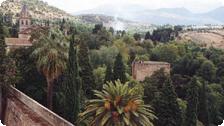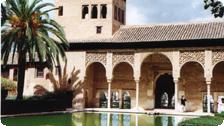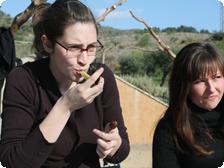Culture: Spain: The Sultan’s Tea
by Wendy H. King
An unexpected, late-September afternoon rain bombarded Granada, interrupting my walk in the Albayzín, the old Muslim quarter of the former capital of the Moorish Empire. I found sanctuary from the downpour in an Arab teahouse, or tetería, until the rain subsided.
Golden-velvet light, swirling Middle Eastern music, and incense immediately soothed me as I entered, hushing the noisy, modern world outside. Patrons conversed quietly within the teahouse’s pomegranate-painted walls. I found the last unoccupied table in a dark corner on the lower level.
I realized how weary my tourist body was the moment I sat down. I had spent most of the day exploring every magnificent inch of the Alhambra and Generalife gardens. Moorish sculpture, mosaics, columns, arches, and Arabic inscriptions had entertained me for hours as I maintained a marathon pace, fulfilling my dream to walk the palace and its grounds.
The young, dark-haired waitress handed me a menu with a tantalizing selection of teas and sweets. Orange, jasmine, cinnamon, cardamom, and bergamot teas—along with some delightfully mysterious infusions—tempted me. One particular blend of eight different teas called out to me. Like a cowboy ordering a double shot of whiskey at a saloon after a long day riding, I chose that tea.
The hostess returned shortly and gracefully placed a small, silver teapot with ornate geometric designs on the knee-high table. I opened the lid reverently, inhaled the teapot’s contents, and closed my eyes. The aroma instantly enticed me.
I poured the infusion into a small, gold-trimmed glass etched with white floral designs, and lifted it to my lips. The magical, milky liquid coursed down my throat and through my body, gently sedating me with its calming waves. Surely this was the beverage that revived and quenched the thirst of the sultans so many centuries ago.
As it took away my chill and fatigue, the warm brew—combined with the calming music, floating incense, and tranquility of the teahouse—connected me to the Moorish culture. I felt the power of the empire, the heart of its people, their reverence for beauty.
Earlier in the day I had experienced the majesty of the Alhambra and the loveliness of its lush gardens from a visual, exterior perspective. The tea enabled me to experience the culture from within.
I ordered another pot, not wanting the moment to end. A type of communion occurred that afternoon: the Moors and I became as one.
At dinner that evening, my thoughts meandered back to the Arab teahouse. As I drifted off to sleep around midnight, in my hotel below the illuminated Alhambra, I vowed to return to that Arab teahouse the next morning to indulge myself one last time before I returned to Madrid.
To my disappointment, the teahouse was closed. No sign on the door listed its business hours or even its name. I wandered through the narrow streets of the Albayzin, dejected as though I had lost a lover.
My spirits brightened when I found a tea shop just as it was opening its doors for business. Certainly I would be able to find the enchanted tea there.
The proprietor, wearing a turban and dressed in a long, snowy white robe, stood by the shop’s door, beckoning me as though he knew what I sought. A young woman in a billowy dress stood behind the counter of the small, modestly stocked store. Near the window, I found a small selection of cellophane-wrapped teas, one of which was labeled Sueños de Alhambra: Dreams of Alhambra. I held it to my nose. Confident it was the tea I had savored the day before, I purchased it.
When I returned to San Francisco the following week, I immediately brewed the tea, hoping to reconnect with the Moors as I had thousands of miles away at the teahouse in Granada. Yet although the tea was delicious, it did not produce the magical effect I expected. I realized then that only in Granada, below the Alhambra, does the tea releases its powers.
Now and again, I open my jar of tea, inhale the contents, and remember when, for a brief moment, my soul merged with the ancient Moorish world. I am forever indebted to the rain that day in Granada for changing my path—and to my own stubbornness in refusing to pack an umbrella.
Getting There
International and domestic flights to Granada are available. From Madrid, the Talgo train takes about five and a half hours; from Seville, the trip takes about four hours. There is no high-speed train service to Granada. Website for Spain’s trains, RENFE: target=”_blank” class=”link”>horarios.renfe.es/hir/ingles.html
The scenic bus ride between Granada and Madrid takes about five hours, stopping once for passengers to stretch and grab a quick bite to eat. Buses are modern and comfortable, and passengers can even watch movies. There are several buses that connect to other large cities daily.
Places to visit
• Alhambra and Generalife gardens: allow plenty of time to visit. Definitely not a place to rush through. If you plan to spend most of the day exploring it, pack a lunch. Night tours are also available.
• Albayzín, the old Moorish quarter of Granada
• Cathedral
• Capilla Real (Royal Chapel), which houses the marble tombs of Queen Isabel and King Ferdinand.
Places to stay
• Hotel Macia: Plaza Nueva 4 (tel 958.227536)
• Casa del Alijarife: Placeta de la Cruz Verde 2 (tel 958.222425), Albaycín area
• Hotel La Perla: Calle Reyes Catolicos 2 (tel 958.223415), near the cathedral
• Albergue Juvenil (Youth Hostel): Camino de Ronda 171 (tel 958.284306)
Food
• Restaurants: El Ladrillo II, Calle Panaderos, Albayzín (for great seafood)
• Tapas Bars: ideal for solo travelers who feel self-concious eating alone, they’re also great places to meet locals. Tapas bars serve small plates such as olives, chicken, seafood, and cured meats, and you eat standing. If you are very hungry, order a ración, which is a larger, meal-sized portion.
Pastries
Be sure to indulge in the wonderful honey-and-almond sweets found in the Albaycín teahouses and bakeries
Things to buy
Marquetry boxes
Granada’s teahouses
Located on Caldereria Nueva and Caldereria Vieja in the Albaycín
Places to see flamenco
• Los Tarantos: Camino de Sacromonte, 9 (tel 958.224525)
• Tablao Albaycín: Rd. de Murcia (tel 958.804646)
Helpful websites
• www.andalucia.com/cities/granada.htm
Things to bring
• Comfortable walking shoes
• A Spanish phrase book and pocket-size dictionary
• Guidebook for the Alhambra
• Sunscreen
Discover more from Tango Diva
Subscribe to get the latest posts sent to your email.











